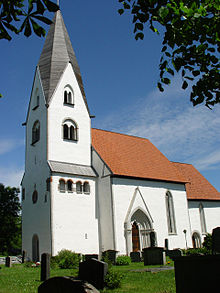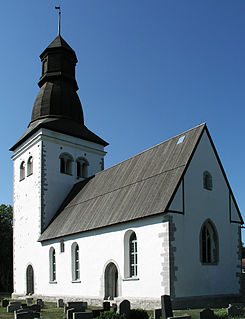
Ala Church is a medieval church in Ala on the Swedish island of Gotland. Its oldest parts date from the 12th century. Damaged by fire in the 1930s, it still contains medieval murals and its original baptismal font. The church belongs to the Church of Sweden and lies within the Diocese of Visby.
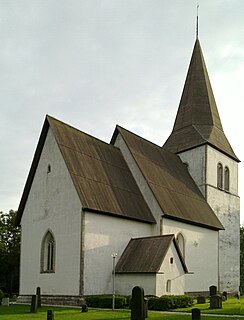
Etelmhem Church is a medieval church on the Swedish island of Gotland. The largely Gothic church contains medieval murals and a 12th-century baptismal font by the sculptor Hegvald. The church is used by the Church of Sweden and part of Diocese of Visby.

Buttle Church is a medieval church in Buttle on the Swedish island of Gotland. It is one of the more well-preserved Romanesque churches on Gotland, and contains both a number of medieval furnishings as well medieval murals. Buttle Church belongs to the Diocese of Visby of the Church of Sweden.

Rone Church is a medieval church in Rone on the Swedish island of Gotland. The Gothic church contains a number of medieval murals. It is part of the Church of Sweden and lies in the Diocese of Visby.
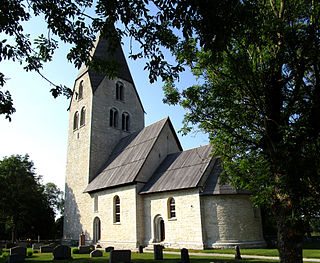
Ganthem Church is a well-preserved Romanesque church in Ganthem on the island of Gotland. It contains murals from the 15th century as well as a number of medieval furnishings. It lies in the Diocese of Visby (Sweden).
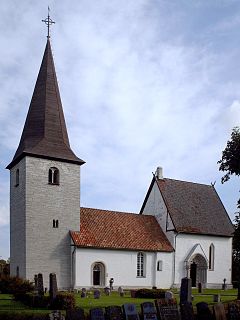
Halla Church is a medieval church in Halla on the Swedish island Gotland. It is part of the Diocese of Visby.

Lojsta Church is a medieval church in Lojsta on the Swedish island of Gotland. The well-preserved church contains several sets of medieval murals. It belongs to the Diocese of Visby within the Church of Sweden.
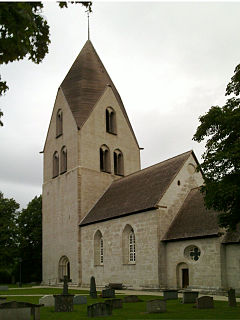
Mästerby Church is a medieval church in Mästerby on the Swedish island of Gotland. It is richly decorated with medieval murals. Mästerby Church belongs to the Diocese of Visby.

Stora Hammar Old Church is a medieval Lutheran church in south-western Scania, Sweden. It belongs to the Diocese of Lund.

Sjonhem Church is a medieval church on the island of Gotland, Sweden. It belongs to the Diocese of Visby.

Östra Vemmerlöv Church is a medieval church in Östra Vemmerlöv, in the province of Skåne, Sweden. It belongs to the Diocese of Lund. It contains many medieval mural paintings.

Bjäresjö Church is a medieval church in Bjäresjö, in the province of Skåne, Sweden. The church contains several medieval mural paintings as well as a richly decorated Romanesque baptismal font.

Emmislöv Church is a church in Emmislöv, Östra Göinge Municipality, Sweden. It was built c. 1200 and contains several medieval murals.

Hjärsås Church is a medieval church in Hjärsås, Östra Göinge Municipality, Skåne, Sweden. It was built in the 1230s in a Romanesque style. Unusually, the church exterior is decorated with paintings possibly from the 16th century. The interior contains 16th-century murals of a style not found elsewhere in Skåne. The church lies in the Diocese of Lund.

Övraby Church is a medieval church in Tomelilla Municipality, Scania, Sweden.

Silvåkra Church is a medieval church in Silvåkra, Lund Municipality, Scania, Sweden. The church is decorated with church murals from both the 12th and the 16th centuries, and still has some medieval furnishings.

Othem Church is a medieval church in Othem on Gotland, Sweden. It was built in the 13th century and contains several medieval murals.

Hamra Church is a medieval church in Hamra, Gotland, Sweden.

Fjelie Church is a medieval church in Fjelie, Lomma Municipality, Scania, Sweden. The church is decorated with church murals from the 13th, 14th and 15th centuries, and also contains medieval furnishings.

Östra Vram Church is a church in Östra Vram, a village in Kristianstad Municipality, Scania, Sweden. It is a well-preserved medieval church, still containing several medieval works of art as well as murals from the 14th century.
